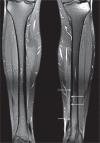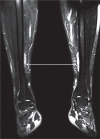Tibial stress injuries - location, severity, and classification in magnetic resonance imaging examination
- PMID: 30655927
- PMCID: PMC6334187
- DOI: 10.5114/pjr.2018.80218
Tibial stress injuries - location, severity, and classification in magnetic resonance imaging examination
Abstract
Purpose: To describe and illustrate the spectrum of magnetic resonance imaging (MRI) findings of tibial stress injuries (TSI) and propose a simplified classification system.
Material and methods: Retrospective analysis of MRI exams of 44 patients with clinical suspicion of unilateral or bilateral TSI, using a modified classification system to evaluate the intensity and location of soft-tissue changes and bone changes.
Results: Most of the patients were young athletic men diagnosed in late stage of TSI. Changes were predominantly found in the middle and distal parts of tibias along medial and posterior borders.
Conclusions: TSI may be suspected in young, healthy patients with exertional lower leg pain. MRI is the only diagnostic method to visualise early oedematic signs of TSI. Knowledge of typical locations of TSI can be helpful in proper diagnosis before its evolution to stress fracture.
Keywords: athletic injuries; fractures; soft tissue injuries; stress; tibial fractures; tibial stress syndrome.
Figures


















References
-
- Gaeta M, Minutoli F, Scribano E, et al. CT and MR imaging findings in athletes with early tibial stress injuries: Comparison with bone scintigraphy findings and emphasis on cortical abnormalities. Radiology. 2005;235:553–561. - PubMed
-
- Fredericson M, Bergman AG, Hoffman KL, et al. Tibial stress reaction in runners: correlation of clinical symptoms and scintigraphy with a new magnetic resonance imaging grading system. Am J Sports Med. 1995;23:427–481. - PubMed
-
- Kijowski R, Choi J, Shinki K, et al. Validation of MRI classification system for tibial stress injuries. AJR Am J Roentgenol. 2012;198:878–884. - PubMed
-
- Beck BR, Bergman AG, Arendt EA, et al. Tibial stress injury: relationship of radiographics, nuclear medicine bone scanning, MR Imaging, and CT severity grades to clinical severity and time to healing. Radiology. 2012;263:811–818. - PubMed
LinkOut - more resources
Full Text Sources
